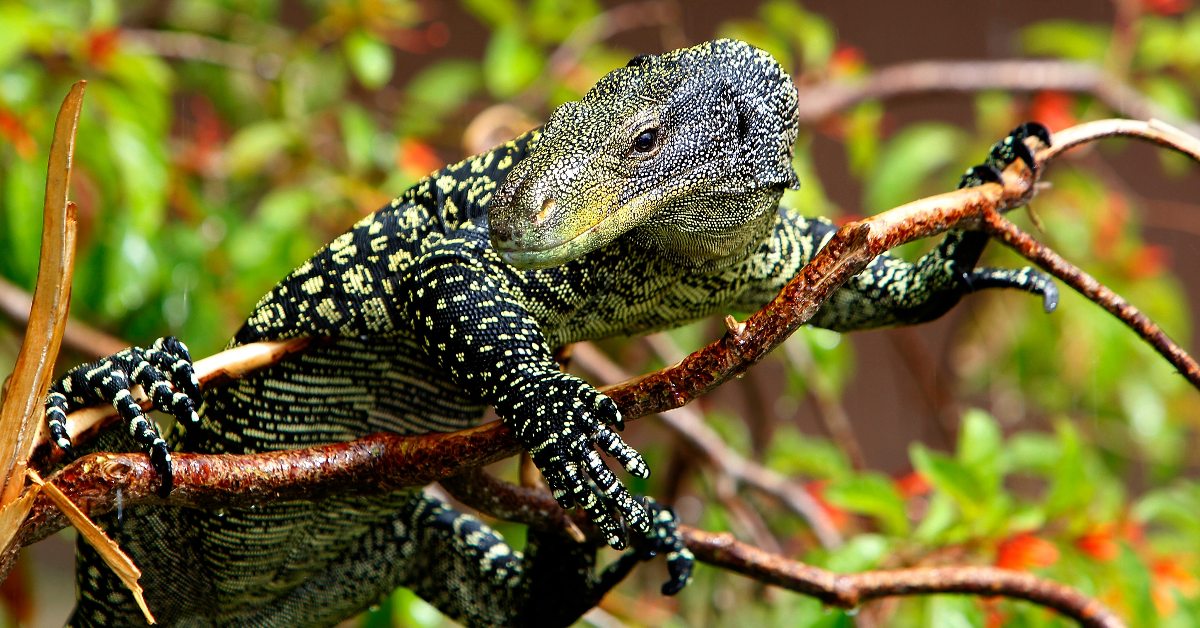Big Monitor
I ran the Charm City Reptile and Amphibian Rescue for 14 years (no longer in operation). Here is a story about a rescued monitor lizard.
I got a phone call from a Mid-Atlantic Reptile Show volunteer. He said that friends of his lived in a rural area in Baltimore County. Imagine their complete shock when they discovered a large lizard. It’s tongue was flicking at the scents in the air, majestically scanning the area by looking side to side, while climbing up their screen door. It was big, several feet in length and they thought it was probably a Nile monitor. Not known for their sweetness, the volunteer donned a pair of welding gloves and went to his friend’s house to retrieve the unwelcome guest. The volunteer took an old canvas mail bag with him. He carefully placed the now angry beast into the bag to carry the animal.
The volunteer brought the lizard over to my house and my friend Tom, who used to work as a herpetologist at the Reptile House at the Baltimore Zoo, came over to give me a hand. The volunteer handed me the squirming bag and left. He said the lizard had an injury with maggots in it, but it was in good shape otherwise. And it was nasty. Of course, it was a Nile monitor.
We had a 50-gallon tank set up for it, but it wasn’t really big enough to keep a monitor that size long term. It was what we had at the time though. Often our caging is not optimal, but the cages are not unlike kennels at the pound. They are also not the best choice, but it makes it easier to house a lot of animals.
We pulled the animal out of the bag and put it into the 50-gallon tank. Tom said, “That’s not a Nile monitor! That’s a croc monitor! While I didn’t understand the significance of that statement at the time, I soon did.
Crocodile monitors are the longest lizard species in the world. They can get about 15 feet in length. Komodo dragons get heavier, but max out at about eight and a half feet. Nile monitors and Komodo dragons are not as colorful as this beautiful animal. It was vibrant black with bright yellow markings on it.
The tip of the croc monitor’s tail was missing and there was an injury on his rear leg that did indeed have maggots. I learned from our vet that maggots actually help out when they are in an open wound. They eat infection. Gross out material, for sure. However, the hungry little maggots worked hard to keep the wound clean. Maggots are one of nature’s clean-up crews.
The following day I bagged it and took it to the vet. She said that every time she thought she had all of the maggots out, she found another one. My vet, not a huge fan of bugs, was a real trooper picking out a hundred or so maggots! Using forceps, she plucked the little critters from the wound, careful not to poke the monitor too much while doing it.
She debrided (cleaned up) the wound and put in some stitches. At that time I wasn’t taking out stitches myself, which I am able to do now. And I have a nice pair of suture scissors. I was a rookie back then!
I just had to give that black and yellow beast oral antibiotics, which was easy when they were inserted under the skin of a pre-killed mouse. (Sorry if you’re squeamish.) If you have an animal that eats as often as antibiotics need to be administered, it’s easy to hide the medication in food. That works especially well if the animal in question is a good feeder. If they are not eating because they are sick, it becomes a little more complicated.
I have to say that the croc monitor did make me a little bit nervous at the time. I was relatively new to the rescue business and had never dealt with a monitor that was as clever and devious as a croc monitor. While croc monitors don’t have the dangerous bacteria that Komodo dragons have, they do eat carrion in the wild. That means the lizard’s mouths are very dirty. A bite from a croc monitor would probably cause an infection, and the person would have to take a course of antibiotics. Thankfully, I was able to avoid getting bitten or scratched by this animal.
The reptile rumor mill took over, and I eventually got a call from a well-known local reptile breeder who had lost the monitor. It had escaped from its cage and also someone had left a door open. By the time they had discovered the animal was missing, it was long gone. I offered to give it back, but he didn’t want people to know that he had lost it. I told him I’d keep it between us, no problem. He told me to keep it and get a nice adoption fee for it. Wonderful! I loved that idea.
Tom came back over and helped with cage cleaning for that animal. The monitor was a handful! One time Tom was holding the croc monitor and it tried to bite him and instead slashed his shoe. It cut into the leather like a hot knife through butter. The evenly spaced slits demonstrated that the monitor had quite a set of teeth, and they were razor sharp.
Word got out into the reptile community about this animal. I had many calls about it. I knew it was worth a decent amount of money and told people that. Most were not interested in paying a large adoption fee. After several months, it was adopted. It was about three feet long when it left here. The last time I saw it, it was about eight feet long, living in a gigantic enclosure and enjoying dinners of adult-sized rabbits. Because of that croc monitor, I actually met several people who are still friends to this day.
Please leave your comments below.
Read more by Holli Friedland.

